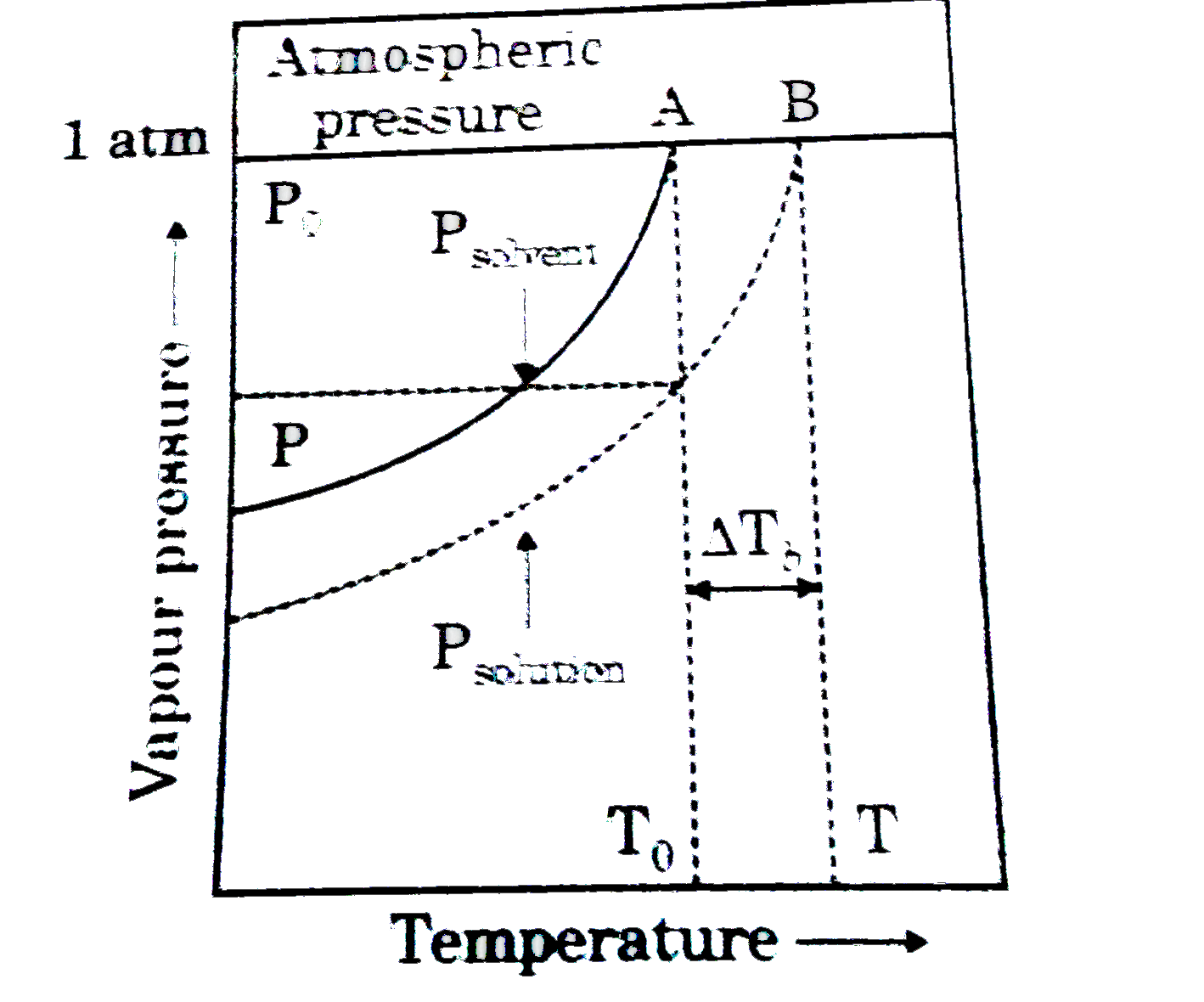Mole fraction of a non-electrolyte in aqueous solution is 0.07. If Kf is 1.86∘mol−1kg, depression if f.p.,ΔTf, is:
0.26∘
1.86∘
0.13∘
7.78∘
The correct Answer is:D
To solve the problem, we need to calculate the depression in freezing point (ΔTf) of an aqueous solution given the mole fraction of a non-electrolyte and the cryoscopic constant (Kf).
1. Identify the Given Data:
- Mole fraction of non-electrolyte (x2) = 0.07
- Cryoscopic constant (Kf) = 1.86 °C kg/mol
2. Calculate the Mole Fraction of the Solvent:
- The mole fraction of the solvent (water, x1) can be calculated using the formula:
x1=1−x2
- Substitute the value of x2:
x1=1−0.07=0.93
3. Determine the Molarity of the Solution:
- The molarity (m) of the solution can be calculated using the formula:
m=moles of solutemass of solvent (kg)
- To find the moles of solute, we can use the mole fraction:
moles of solute=x2×total moles
- Assuming 1 kg of solvent (water), the mass of the solvent in grams is 1000 g. Since the molar mass of water is approximately 18 g/mol, the moles of solvent can be calculated as:
moles of solvent=1000 g18 g/mol≈55.56 mol
- The moles of solute (non-electrolyte) can be calculated as:
moles of solute=0.07×(0.07+0.93)≈0.07 mol
- Now, we can calculate the molarity:
m=0.07 mol1 kg=0.07 mol/kg
4. Calculate the Depression in Freezing Point (ΔTf):
- The formula for depression in freezing point is:
ΔTf=i⋅m⋅Kf
- Since the solute is a non-electrolyte, the van 't Hoff factor (i) = 1.
- Substitute the values into the formula:
ΔTf=1⋅0.07⋅1.86=0.1302 °C
5. Final Calculation:
- The final value of ΔTf is approximately:
ΔTf≈0.1302 °C
Conclusion:
The depression in freezing point (ΔTf) is approximately 0.1302 °C.
- Mole fraction of non-electrolyte (x2) = 0.07
- Cryoscopic constant (Kf) = 1.86 °C kg/mol
- The mole fraction of the solvent (water, x1) can be calculated using the formula:
x1=1−x2
- Substitute the value of x2:
x1=1−0.07=0.93
- The molarity (m) of the solution can be calculated using the formula:
m=moles of solutemass of solvent (kg)
- To find the moles of solute, we can use the mole fraction:
moles of solute=x2×total moles
- Assuming 1 kg of solvent (water), the mass of the solvent in grams is 1000 g. Since the molar mass of water is approximately 18 g/mol, the moles of solvent can be calculated as:
moles of solvent=1000 g18 g/mol≈55.56 mol
- The moles of solute (non-electrolyte) can be calculated as:
moles of solute=0.07×(0.07+0.93)≈0.07 mol
- Now, we can calculate the molarity:
m=0.07 mol1 kg=0.07 mol/kg
- The formula for depression in freezing point is:
ΔTf=i⋅m⋅Kf
- Since the solute is a non-electrolyte, the van 't Hoff factor (i) = 1.
- Substitute the values into the formula:
ΔTf=1⋅0.07⋅1.86=0.1302 °C
- The final value of ΔTf is approximately:
ΔTf≈0.1302 °C
The depression in freezing point (ΔTf) is approximately 0.1302 °C.
Topper's Solved these Questions
- SOLUTIONSBOOK - RESONANCE ENGLISHCHAPTER - SOLUTIONSEXERCISE - Advabced Level Problems (PART-2)
35 Videos
- SOLUTIONSBOOK - RESONANCE ENGLISHCHAPTER - SOLUTIONSEXERCISE - EXERCISE-3(PART-3)
30 Videos
- SOLUTION AND COLLIGATIVE PROPERTIESBOOK - RESONANCE ENGLISHCHAPTER - SOLUTION AND COLLIGATIVE PROPERTIESEXERCISE - PHYSICAL CHEMITRY (SOLUTION & COLLIGATIVE PROPERTIES)
52 Videos
- STEREOISOMERISMBOOK - RESONANCE ENGLISHCHAPTER - STEREOISOMERISMEXERCISE - EXERCISE (PART III : PRACTICE TEST-2 (IIT-JEE (ADVANCED PATTERN))
23 Videos
Similar Questions
Mole fraction of solvent in an aqueous solution is 0.7. What is the molality of this solution in mol/kg?
View SolutionDensity of 1M solution of a non-electrolyte C6H12O6 is 1.18 g/mL . If Kf(H2O) is 1.86∘mol−1 kg , solution freezes at :
View SolutionThe freezing point of a 0.05 molal solution of a non-electrolyte in water is:
(Kf=1.86molality−1)
View SolutionThe relative lowering of vapour pressure of an aqueous solution of a non-volatile solute of molecular weight 60 (which neither dissociates nor associates in the solution) is 0.018. If Kf of water is 1.86∘Cm−1 the depression in freezing point will be :
View SolutionThe mole fraction of a solvent in aqueous solution of a solute is 0.8. The molality (in mol kg−1) of the aqueous solution is:
View SolutionIf the elevation in boiling point of a solution of non-volatile, non-electrolytic and non-associating solute in solvent (Kb=xK.kgmol−1) is yK,then the depression in freezing point of solution of same concentration would be
(Kf )of the solvent = zK.kgmol−1)
View SolutionFigure explains elevation in boiling point when a non-volatile solute is added to a solvent. Variation of vapour pressure with temperaure and elevation in boiling point is marked.

Elevation in b.p of an aqueous urea solution is 0.52∘(Kb=0.52∘mol−1kg). Hence, mole fraction of urea in this solution is:
View SolutionDepression in f.p. of an aqueous urea solutio is 1.86∘.(Kf=1.86∘mol−1kg) Hence, mole− fraction of urea in this soluiton is :
View SolutionThe freezing poing of an aqueous solution of a non-electrolyte is −0.14∘C. The molality of this solution is [Kf(H2O)=1.86kgmol−1]:
View SolutionThe freezing point of an aqueous solution of non-electrolyte having an osmotic pressure of 2.0 atm at 300 K will be, (Kffor H2O=1.86Kmol−1g) and R = 0.0821 litre atm K−1mol−1 . Assume molarity and molarity to be same :
View Solution
